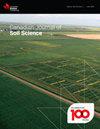泥炭土中泥炭菌的生化成分与持久性
IF 1.5
4区 农林科学
Q4 SOIL SCIENCE
引用次数: 1
摘要
组成植物组织的多糖(纤维素和半纤维素)、蛋白质、酚类木质素和果胶的数量和排列方式在一定程度上决定了植物组织的腐烂率。富含木质素和/或缺氮的组织被描述为生物化学上的顽固性,导致缓慢的腐烂率。尽管有机物质在含矿物颗粒土壤中的储存机制存在争议,但对有机泥炭土(Histosols)的生化顽固性仍知之甚少。为了研究泥炭土在泥炭土形成中的作用,我们对3个泥炭地生态系统中10种泥炭的生物化学成分进行了表征,并研究了这些成分在土壤中150 cm深度的持久性。我们假设来自丘状微形态的物种比来自空心的物种具有更多的生化结构成分和凝聚力。生物化学成分的相对比例在植物材料与泥炭土顶部10 cm之间发生了显著变化,表明分解发生在泥炭土表层,但此后在150 cm深处,生物化学成分的相对比例变化不显著。区分丘状物种和空心物种的生物化学成分的一些差异一直持续到采样的最深处。虽然木质素类成分的持久性是预期的,但可溶性和离子结合果胶化合物的持久性是令人惊讶的,因为这些生物聚合物被认为是容易分解的。我们的研究结果表明,Sphagnum的结构成分,特别是多糖和果胶以及经常被引用的酚类木质素成分,在泥炭土壤中持续存在,并且在试图了解Sphagnum主导的生态系统中的碳动态时不应忽视。本文章由计算机程序翻译,如有差异,请以英文原文为准。
Biochemical components of Sphagnum and persistence in peat soil
Abstract The amounts and arrangements of polysaccharides (cellulose and hemicellulose), proteins, phenolic lignin, and pectin that make up plant tissue, in part, determine its decay rate. Lignin-rich and/or nitrogen-poor tissue has been described as biochemically recalcitrant causing a slow decay rate. Although a controversial mechanism for organic matter storage in soils with mineral particles, biochemical recalcitrance is still poorly understood in organic peat soil (Histosols). To investigate the role of Sphagnum in formation of peat soil, we characterize biochemical components for 10 species and examine persistence of the components in soil to 150 cm depth in three peatland ecosystems. We hypothesize that species from hummock microforms have more biochemical structural components and cohesion than species from hollows. Relative proportions of biochemical components changed markedly between plant material and the top 10 cm of peat soil, suggesting that decomposition occurred at the peat soil surface, but thereafter relative proportions of biochemical components did not vary significantly to 150 cm deep. A few differences in biochemical components that distinguished hummock species from hollow species persisted to the deepest depth sampled. Although persistence of the lignin-like component was expected, persistence of soluble and ionically bound pectin compounds was surprising as these biopolymers are thought to be readily decomposable. Our findings indicate that structural components of Sphagnum, specifically polysaccharides and pectin in addition to oft-cited phenolic lignin-like components, persist in peat soil and should not be overlooked in trying to understand carbon dynamics in Sphagnum-dominated ecosystems.
求助全文
通过发布文献求助,成功后即可免费获取论文全文。
去求助
来源期刊

Canadian Journal of Soil Science
农林科学-土壤科学
CiteScore
2.90
自引率
11.80%
发文量
73
审稿时长
6.0 months
期刊介绍:
The Canadian Journal of Soil Science is an international peer-reviewed journal published in cooperation with the Canadian Society of Soil Science. The journal publishes original research on the use, management, structure and development of soils and draws from the disciplines of soil science, agrometeorology, ecology, agricultural engineering, environmental science, hydrology, forestry, geology, geography and climatology. Research is published in a number of topic sections including: agrometeorology; ecology, biological processes and plant interactions; composition and chemical processes; physical processes and interfaces; genesis, landscape processes and relationships; contamination and environmental stewardship; and management for agricultural, forestry and urban uses.
 求助内容:
求助内容: 应助结果提醒方式:
应助结果提醒方式:


